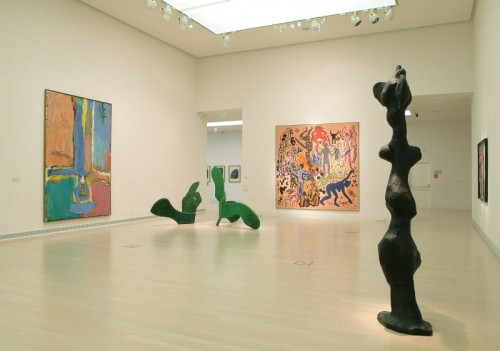Living and working in Berlin since 1992, Sergei Vorontsov started his career at the Stroganov Moscow State University of Arts and Industry as an assistant, and later worked with mosaics at a conglomerate factory serving production for applied art. He studied at the Moscow Institute for the Decorative and Applied Arts and between 1986−88 he was member of the Moscow Avant-garde Club (KLAVA), participating in their first group show. The piece in the Ludwig Museum’s collection reflects Vorontsov’s technical knowledge – he has a predilection for using unusual raw materials, such as cement in his works. Employing spray paint and stencils for his piece Oceanography, he repeats the same combination of motifs in fifteen lines: a moon, a cherry, an apple, a star and a pear clamped between a hammer and a sickle – generating a kind of undulating effect if viewed from afar. The “sea” of copper-coloured motifs on pale background is broken by two prominent black rectangles in the centre. These feature other repetitive symbols, harder to identify than the “basic set” – including what seems to be a rocket and a torpedo. Although it is composed of “tangible” elements, the piece as a whole has an abstract effect: the individual symbols lose their own meaning, forming a repetitive, immaterial, rumbling unit, “clasped” by the artist into a strong black frame. The structure and rhythm of the piece evokes Vorontsov’s close ties with music. Oceanography was made in 1988, a year before Vorontsov’s first exhibition in Berlin at the Galerie Neue Räume.

